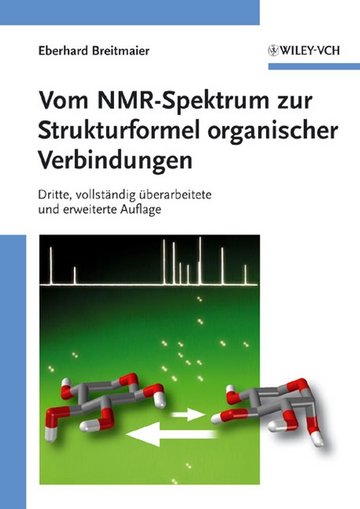| Title Page | 5 |
| Inhaltsverzeichnis | 7 |
| 1 Grundbegriffe, Meßgrössen, Meßverfahren in Kürze | 15 |
| 1.1 Chemische Verschiebung | 15 |
| 1.2 Spin-Spin-Kopplung und Kopplungskonstanten | 15 |
| 1.3 Signalmultiplizität (Multipletts) | 16 |
| 1.4 Spektren erster und höherer Ordnung | 17 |
| 1.5 Chemische und magnetische Äquivalenz | 18 |
| 1.6 Fourier-Transform-(FT-)NMR-Spektren | 19 |
| 1.7 Spin-Entkopplung | 20 |
| 1.8 Kern-Overhauser-Effekt | 22 |
| 1.9 Relaxation, Relaxationszeiten | 24 |
| 2 Erkennung von Strukturmerkmalen durch NMR | 25 |
| 2.1 Funktionelle Gruppen | 25 |
| 2.1.1 1H-Chemische Verschiebungen | 25 |
| 2.1.2 Deuterium-Austausch | 26 |
| 2.1.3 13C-Chemische Verschiebungen | 26 |
| 2.1.4 15N-Chemische Verschiebungen | 28 |
| 2.2 Konstitution (Atomverknüpfungen) | 30 |
| 2.2.1 HH-Multiplizitäten | 30 |
| 2.2.2 CH-Multiplizitäten | 32 |
| 2.2.3 HH-Kopplungskonstanten | 35 |
| 2.2.4 CH-Kopplungskonstanten | 40 |
| 2.2.5 NH-Kopplungskonstanten | 43 |
| 2.2.6 HH-COSY (geminale, vicinale und w-Beziehungen von Protonen) | 44 |
| 2.2.7 CC-INADEQUATE (CC-Bindungen) | 47 |
| 2.2.8 Zuordnung von CH-Bindungen durch zweidimensionale CH-Korrelation | 50 |
| 2.2.9 Zweidimensionale, auf Fernkopplungen abgestimmte CH-Korrelation | 53 |
| 2.3 Relative Konfiguration und Konformation | 56 |
| 2.3.1 HH-Kopplungskonstanten | 56 |
| 2.3.2 CH-Kopplungskonstanten | 60 |
| 2.3.3 NH-Kopplungskonstanten | 61 |
| 2.3.4 13C-Chemische Verschiebungen | 62 |
| 2.3.5 NOE-Differenzspektren | 65 |
| 2.3.6 HH-NOESY und ROESY | 67 |
| 2.4 Absolute Konfiguration | 68 |
| 2.4.1 Diastereotopie | 68 |
| 2.4.2 Chirale Verschiebungsreagenzien (ee-Bestimmung) | 70 |
| 2.5 Intra- und intermolekulare Wechselwirkungen | 72 |
| 2.5.1 Anisotropieeffekte | 72 |
| 2.5.2 Ringstrom aromatischer Verbindungen | 72 |
| 2.5.3 Intra- und intermolekulare Wasserstoffbrücken | 73 |
| 2.5.4 Protonierungseffekte | 74 |
| 2.6 Moleküldynamik | 75 |
| 2.6.1 Temperaturabhängige NMR-Spektren | 75 |
| 2.6.2 13C-Spin-Gitter-Relaxationszeiten | 77 |
| 2.7 Zusammenfassung | 81 |
| 3 Probleme | 83 |
| 1-12 Anwendungen eindimensionaler 1H-NMR-Spektren | 83 |
| 13-14 Temperaturabhängige 1H- und 13C-NMR-Spektren | 97 |
| 15-20 Anwendungen eindimensionaler 13C-NMR-Spektren | 99 |
| 21-22 Kohlenstoffskelette aus CC-INADEQUATE-Experimenten | 105 |
| 23-29 Anwendungen eindimensionaler 1H- und 13C-NMR-Spektren | 107 |
| 30-31 Anwendungen eindimensionaler 1H-, 13C- und 15N-NMR-Spektren | 114 |
| 32-42 Kombinierte Anwendungen ein- und zweidimensionaler 1H- und 13C-NMR-Experimente | 118 |
| 43-55 Aufklärung von Naturstoffen durch ein- und zweidimensionale 1H- und 13C-NMR-Methoden | 142 |
| 4 Problemlösungen | 194 |
| 1 cis-Cyclopropan-1,2-dicarbonsäuredimethylester | 194 |
| 2 Acrylsäureethylester | 194 |
| 3 cis-1-Methoxybut-1-en-3-in | 195 |
| 4 trans-3-(N-Methylpyrrol-2-yl)propenal | 195 |
| 5 1,9-Bis(pyrrol-2-yl)pyrromethen | 196 |
| 6 3-Acetylpyridin | 196 |
| 7 Anthracen-1,8-dialdehyd | 197 |
| 8 trans-Stilben-4-aldehyd | 198 |
| 9 6,4'-Dimethoxyisoflavon | 199 |
| 10 Catechol (3,5,7,3',4'-Pentahydroxyflavan) | 199 |
| 11 Methyloxiran und Monorden | 201 |
| 12 2-Methyl-6-(N,N-dimethylamino)-trans-4-nitro-trans-5-phenyl-cyclohexen | 202 |
| 13 (E)-3-(N,N-Dimethylamino)acrolein | 203 |
| 14 cis-1,2-Dimethylcyclohexan | 204 |
| 15 5-Ethinyl-2-methylpyridin | 205 |
| 16 5-Hydroxy-3-methyl-1H-pyrazol | 206 |
| 17 o-Hydroxyacetophenon | 206 |
| 18 1-Acetonyl-2,4,6-trinitrocyclohexa-2,5-dienat (Kalium-Salz) | 207 |
| 19 trans-3-[4-(N,N-Dimethylamino)phenyl]-2-ethylpropenal | 208 |
| 20 N-Butylsalicylaldimin | 208 |
| 21 Benzo[b]furan | 209 |
| 22 2-Ethylcyclohexa-1,3-dien-5-carbonsäure(3-hydroxypropyl)ester | 209 |
| 23 3-Hexin-1-ol | 210 |
| 24 4-Aminobenzoesäure[2-(N,N-diethylamino)ethyl]ester Hydrochlorid (Procain Hydrochlorid) | 211 |
| 25 5,5´-Bis-(hydroxymethyl)-2,2´-bifuran | 212 |
| 26 N-Methyl-6,7-methylenedioxy-1-oxo-1,2,3,4-tetrahydroisochinolin | 213 |
| 27 2-Ethoxycarbonyl-4-(3-hydroxypropyl)-1-methylpyrrol | 214 |
| 28 p-Tolylsulfonyl-5-propylpyridin | 216 |
| 29 6-Methoxytetralin-1-on | 217 |
| 30 Triazolo[1,5-a]pyrimidin | 219 |
| 31 6-n-Butyltetrazolo[1,5-a]pyrimidin und 2-Azido-5-n-butylpyrimidin | 219 |
| 32 Hydroxyphthalid | 221 |
| 33 Dicyclopentadien | 221 |
| 34 trans-1-Cyclopropyl-2-methyl-1,3-butadien | 222 |
| 35 cis-6-Hydroxy-1-methyl-4-isopropylcyclohexen (Carveol) | 224 |
| 36 trans-2-Methylcyclopentanol | 225 |
| 37 trans-2-(2-Pyridyl)methylcyclohexanol | 225 |
| 38 Nona-2-trans-6-cis–dienal | 226 |
| 39 2,3-Diaza-7,8,12,13,17,18-hexaethylporphyrin | 227 |
| 40 2-Hydroxy-3,4,3',4'-tetramethoxydeoxybenzoin | 228 |
| 41 3',4',7,8-Tetramethoxyisoflavon | 230 |
| 42 3',4',6,7-Tetramethoxy-3-phenylcoumarin | 231 |
| 43 Aflatoxin B1 | 232 |
| 44 1,5-Dimethylcyclohexa-1,3-dien-5-ol-6-on, Dimer | 234 |
| 45 Asperulosid | 236 |
| 46 Lacto-N-tetrose | 239 |
| 47 9-Hydroxycostussäure | 240 |
| 48 14-(Umbelliferon-7-O-yl)driman-3,8-diol | 243 |
| 49 3,4,5-Trimethyl-5,6-dihydronaphtho[2,3-b]furan | 246 |
| 50 Sendarwin | 248 |
| 51 Panaxatriol | 251 |
| 52 trans-N-Methyl-4-methoxyprolin | 254 |
| 53 Cocain-Hydrochlorid | 256 |
| 54 Viridiflorinsäure-7-retronecinester (Heliospathulin) | 258 |
| 55 Actinomycin-D | 260 |
| Bibliographie | 264 |
| Formelverzeichnis der Problemlösungen | 266 |
| Sachverzeichnis | 269 |

















